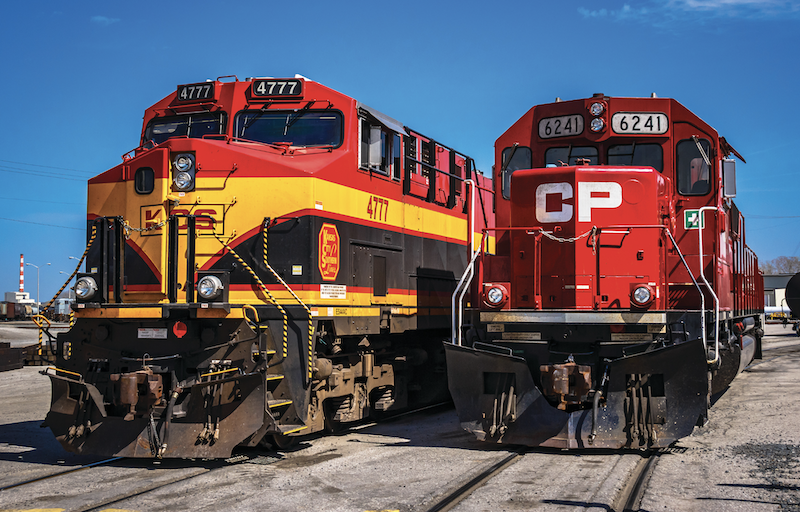By Justin Franz
This week, the editors of Railfan & Railroad Magazine are looking at some of the biggest stories in railroading in 2023. Be sure to check Railfan.com every weekday all year long for all your (free) railroad news and if you like what you see, consider subscribing.
Every year, railroads are bought and sold. This year was no exception. In August, Massachusetts’ Pioneer Valley Railroad was sold to Gulf & Atlantic Railways. In December, OmniTRAX took control of West Virginia’s South Branch Valley. A few days later, it was announced the Canadian National would buy Iowa Northern. And at the end of this month, BNSF Railway will take control of fan-favorite Montana Rail Link.
But those transactions paled in comparison to one nearly a quarter century in the making: The last Class I merger, which saw Canadian Pacific and Kansas City Southern form CPKC.
In 2000, after a flurry of consolidation in the 1980s and 1990s, the U.S. Surface Transportation Board put a temporary end to Class I mergers after BNSF Railway and Canadian National proposed one. At the time, the independent regulator needed to review the ground rules for railroad consolidation and by the time it came out with new regulations, BNSF and CN had given up on their plans. The new rules put forth by the STB set a higher bar for approving such mergers to ensure that they were in the public interest. As a result, while some teased mergers (specifically Hunter Harrison, who tried to pair up CP with CSX and Norfolk Southern on different occasions), none of the final seven Class Is made a serious attempt to combine for two decades.
But those revised merger rules put out in 2001 had a caveat: Kansas City Southern, the smallest of the “Big Seven,” was exempt. The assumption was that KCS would eventually be gobbled up by a competitor and that would be it so long as the STB remained cold to more consolidation. That scenario finally began to develop in 2021, when CP announced it intended to merge with KCS. After a brief bidding war with CN, CP and KCS finally solidified their deal and went to regulators to approve it. Even if the CP-KCS combination was judged by the “easier” rules it was still a lengthy process. But on March 15, the STB issued its final ruling: CP and KCS could become one.
“We made this decision because on the balance the merger of these two railroads will have a positive impact on the American economy and improve, for all citizens, safety and the environment,” said STB Chairman Martin Oberman during a press conference shortly after the decision was released.
The merger of North America’s two smallest Class I railroads resulted in the biggest shift in railroading since Conrail was split between CSX Transportation and Norfolk Southern in 1999. It also resulted in the first Class I to have a major presence in the U.S., Canada and Mexico, with 19,200 miles of track stretching across the continent. The two railroads formally combined on April 14, with a “Final Spike” ceremony in Kansas City.
The STB noted that even merged into one, CPKC was the smallest of North America’s Class I railroads and that it would be a true “end-to-end” merger, meaning rail shippers were likely to benefit from additional reach. However, to ensure that shippers, rail passengers and other stakeholders are not negatively impacted, the STB implemented an “unprecedented” seven-year oversight period over the merged railroad. That meant CPKC would have to give regular updates to the board on its operations and prove that critical interchange gateways remained open at commercially reasonable rates. Such oversight suggests that it could be some time before observers get a full picture of how the merger changed the landscape for shippers.
For railfans trackside though, the changes have been both noticeable and subtle. While the railroad has a new identity, in some places you might not notice much has changed as pure sets of pre-merger locomotives are still common and no CPKC-branded units have yet left the paint shop. In some instances, new CP and KCS-painted locomotives are still being released onto the system as the railroad puts the finishing touches on its final scheme, which was revealed this summer. But in other instances, it’s clear that the CP was the dominant partner, most notably in the fact that the road’s iconic beaver shield plays a prominent role in CPKC’s image. And the railroad’s biggest ambassador, CP 4-6-4 2816, will be wearing CP maroon when it runs to Mexico this coming spring.
It’s likely that CP and KCS units will be roaming the rails for years to come — after all, more than a quarter century after the BNSF Railway merger, it’s still possible to see Santa Fe and Burlington Northern units. But eventually, CPKC locomotives will become the rule rather than the exception and that change will have begun in 2023, making the biggest story of the last 12 months.



